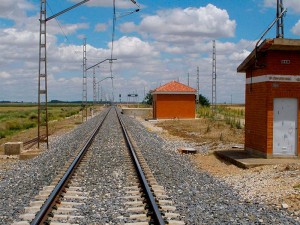Track gauge is defined as the distance between the inside edges of the rails forming the track, measuring exactly 14 millimetres (mm) less than the rail head on each track. Railway tracks all over the world have more than twenty different sizes ranging between 250 mm and 2,134 mm, as a result of which, at a Bern conference in 1886, the decision was taken to introduce the international track gauge size: 1,435 mm. Today, this distance between rails can be found in almost 60% of all railways in the world, particularly in Europe and North America, although the Iberian peninsula has its own gauge size, wider than standard at 1,668 mm, given that the complicated orography demanded greater stability achieved by the increased distance between rails.
This situation represents an obvious commercial disadvantage with respect to the majority of European countries that use the international or standard gauge, owing to the fact that the vehicles must be adapted to said size, with the subsequent loss of time, which also comes at a higher cost.
There are different alternatives for adapting the gauge size such as, for example, the installation of a third rail to complement the Iberian gauge, or a direct change of train axles; however, all of these options are either very costly or are not competitive measures, given that today a goods train requires a stop of up to 6 hours at the border to adapt to the different track gauges.
Track gauge solutions
There are more than 100,000 kilometres (km) of rail track in the world, and Spain has more than 11,000 km of track registered with the Iberian gauge, meaning that changing all of these gauges to the standard size would not be economically viable given that the Administrator of Railway Infrastructures (Administrador de Infraestructuras Ferroviarias – ADIF) estimates that it would take a budget of more than 50,000 million euros. In view of this, for years now work has been underway to develop axles with wheel widths permitting adaptation to the different rail distances.
Thus, passenger trains already have two competitive models of variable axle widths, the Talgo and Brava systems, the latter of which was developed by the company Construcciones y Auxiliar de Ferrocarriles (CAF); however, it has not been possible to install these systems on goods convoys owing to the great weight these machines must withstand.
Variable gauge for goods transport
Spain is one of the entrance doors to Europe by the Mediterranean route running between Algeciras and France, making it one of the countries most deeply involved in developing a variable gauge for goods transport. In 2011 ADIF commissioned two national companies, the Grupo Izva and Tría Ingeniería, to create a variable gauge for goods trains. These companies, in turn, returned to an invitation for tenders issued by ADIF itself in 1966 in the search for a variable gauge. The tender was awarded to the company from Seville, OGI, although it was the Talgo project that was finally introduced to the national railways.
The Grupo Izva, Tría Ingeniería and OGI therefore set about adapting this design from the 60s to create a variable gauge that could be commercialised from the beginning of 2017, given that the project has passed the test stage with more than 25 million kilometres and loads of 25 tonnes per axle. Furthermore, this technology breakthrough, for which ADIF holds the European operating licence for the coming 20 years, will have a global sphere of application in places that frequently use the Iberian gauge, such as Latin American countries, Russia and other eastern countries that were part of the Soviet Union in its day.
As a company specialising in transitory transport services and the handling of all kinds of goods, at Bilogistik we always use the railway provided that doing so guarantees the best price and/or speed of service. At Bilogistic we seek optimised logistics solutions that include the possibility of combining land, sea and air transport.


